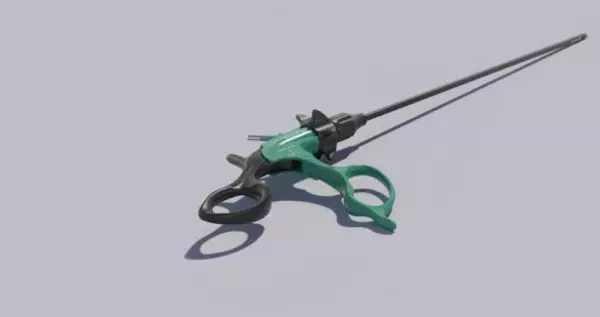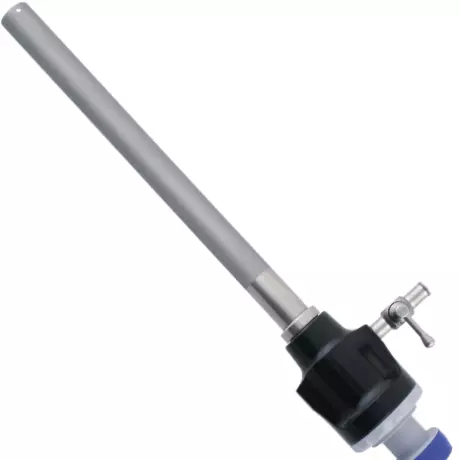
Modular System for Ergonomic and Efficient Work. ErgoSys is an optimal modular system for every f...
Portal and digital medical technology fair of the largest MedTech cluster in Germany

Modular System for Ergonomic and Efficient Work. ErgoSys is an optimal modular system for every f...

Devices and instruments for laparoscopy by...
Laparoscopy With a complete range of units and instruments for laparoscopy, Tekno-Medical has bec...

Laparoscopic cannulas and trocars have a standard, uniform diameter. The standard cannula has a single, five-millimeter-diameter aperture. Alternative embodiments have two or more apertures and a movable member with a coaxial handle. The latter has a fixed, locking mechanism and can be used for a variety of purposes, including inserting guide wires, catheters, or other medical devices.
The cannula and movable member are connected with a helical or spiral-like lumen. The movable member is preferably equipped with a valve 16 that is fixed in the passageway. A valve 16 is provided for airtight sealing around large-diameter laparoscopic instruments. The fixed valve also prevents air leakage from the cannula when not in use.
The instrument is inserted through the cannula, which is often a metal tube. A small, round-diameter instrument is inserted through the hole in the cannula to allow for a better view. A reducer prevents gas from escaping during the procedure by reducing the cannula's diameter. A smaller instrument will not be able to pass through the cannula's lumen.
The movable member may contain additional valves and are selectively movable across the lumen. These features enable larger medical devices to be inserted through the cannula, as in FIG. 2. The gasket is positioned adjacent to the cannula's lumen and provides a fluid-tight seal. In addition, the gasket is preferably sized to reduce the amount of contact between the instrument and the cannula. During insertion, air can be emitted from the cannula if it comes into contact with the instrument.
Laparoscopic cannulas can be divided into two classes: class I and class II. The cannulas contain a one-way valve that allows for insertion of instruments while maintaining the pneumoperitoneum. Multifunctional valves are designed to release insufflation gas. The lateral Luer lock connector provides stability during laparoscopic surgery. The ridged cannulas are used for a variety of procedures.
Cannulas and reusable cones are used for laparoscopic surgery. The cone stabilizes the cannula on the abdominal wall. This cone can also be used to repair the surgical site after the procedure. The reusable cone is a moveable laparoscopic cannula fitted with suture holders. The sutures run through the operative site to hold the cannula in place.
The laparoscopic cannula is a flexible tube that forms a fluid-tight seal around a laparoscopic camera and instruments. There are different outer diameters of the cannula. The abdomen should be distended, and gas should be injected at a pressure of 12 torr into the abdominal cavity. The gas helps to support the abdominal wall from rupturing internal organs.
There are many types of laparoscopic cannulas, and the type of valve should be determined by the surgeon. Generally, large-diameter cannulas are better for larger instruments. The cannulas should have a dual-valve or slit valve. However, a single-valve system is more likely to leak. If you are having surgery performed with the same cannula, a reusable one is recommended.
The endotip cannula is a commonly used laparoscopic cannula. It is often used for a variety of purposes. For example, it is used for the removal of a uterus. Another type of laparoscopic cannula is the EndoTIP cannula. The EndoTIP cannula is used for the removal of an appendix, while the EndoTIP is used for a number of other procedures.
A laparoscopic cannula is a long, thin tube that is inserted into a patient's body. It contains a housing that allows a medical device to be inserted. A movable member is mounted on the end of the cannula and is movable from its first position to a second. A surgeon can move the cannula as needed to reach different areas of the abdomen.
The screw-in cannula is placed in the sub-xyphoid position. A small skin incision is made caudal to the xyphoid. The cannula should be angled towards the hemithorax at a 300-degree angle. A perpendicular angle of the cannula allows the instrument to penetrate the abdominal cavity and the diaphragm.
Become a digital exhibitor yourself in the online portal of the largest and best-known MedTech cluster region in Germany and inform the world of medical technology about your products and services as well as about news, events and career opportunities.
With an attractive online profile, we will help you to present yourself professionally on our portal as well as on Google and on social media.